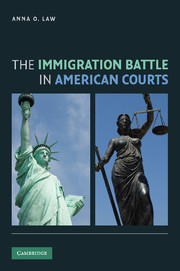Book contents
- Frontmatter
- Contents
- List of Tables and Figures
- Acknowledgments
- 1 Introduction
- 2 How Do We Know What We Know? Data, Methods, and Initial Findings
- 3 The Rise of Two Courts with Differentiated Functions
- 4 Interstitial Policy Making in the U.S. Courts of Appeals
- 5 Institutional Growth and Innovation: The Ninth Circuit Court of Appeals and Immigration
- 6 Continuity Amid Change: The Federal Courts' Commitment to Due Process
- 7 Conclusion
- Appendix A Further Elaboration of Case Selection Methods
- Appendix B Further Elaboration on the Search for Modes of Legal Reasoning
- Appendix C Numerical Codes for Modes of Legal Reasoning
- Appendix D Interview Questions
- Index
- References
4 - Interstitial Policy Making in the U.S. Courts of Appeals
Published online by Cambridge University Press: 04 August 2010
- Frontmatter
- Contents
- List of Tables and Figures
- Acknowledgments
- 1 Introduction
- 2 How Do We Know What We Know? Data, Methods, and Initial Findings
- 3 The Rise of Two Courts with Differentiated Functions
- 4 Interstitial Policy Making in the U.S. Courts of Appeals
- 5 Institutional Growth and Innovation: The Ninth Circuit Court of Appeals and Immigration
- 6 Continuity Amid Change: The Federal Courts' Commitment to Due Process
- 7 Conclusion
- Appendix A Further Elaboration of Case Selection Methods
- Appendix B Further Elaboration on the Search for Modes of Legal Reasoning
- Appendix C Numerical Codes for Modes of Legal Reasoning
- Appendix D Interview Questions
- Index
- References
Summary
The federal courts are distinct from the immigration bureaucracy, Congress, and the presidency because, as courts of law, they embody institutional rules and norms that are indigenous and specific to legal institutions, such as doctrinal constraints and the hierarchical nature of the appellate process. Unlike the legislative and the executive branches, where overt and aggressive political maneuvering to obtain one's objective is allowable and expected, in the judicial branch this same behavior in the appointed branch of government is construed as inappropriate, if not illegal. As a result, while some modes of legal reasoning, such as textualism, structuralism, doctrine, and others are acceptable in deciding cases, other modes of legal reasoning, such as one's personal views (in this instance, on immigration policy or toward particular nationalities) or personal whims, are illegitimate in the context of legal decision making.
Nevertheless, there are still opportunities for judges and justices to engage in behavior with an intent to reach one legal result over another. While much of the tactical maneuvering that goes on at the Supreme Court takes place in the form of interactions and reactions of the justices to each other, similar behavior at contemporary U.S. Courts of Appeals is subtler. As Judge A characterized it, the nature of the U.S. Courts of Appeals is that those courts are “interstitial policy makers.”
- Type
- Chapter
- Information
- The Immigration Battle in American Courts , pp. 102 - 143Publisher: Cambridge University PressPrint publication year: 2010



